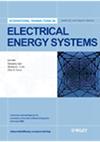Study on microstructure and electrical properties of oil‐impregnated paper insulation after exposure to partial discharge
Jiaming Yan, R. Liao, Lijun Yang, Jian Li
{"title":"Study on microstructure and electrical properties of oil‐impregnated paper insulation after exposure to partial discharge","authors":"Jiaming Yan, R. Liao, Lijun Yang, Jian Li","doi":"10.1002/ETEP.600","DOIUrl":null,"url":null,"abstract":"SUMMARY \n \nThis paper studied microstructure and its relationship with electrical properties for oil-impregnated paper insulation during partial discharge damage process. Material analysis apparatuses such as for atomic force microscopy and X-ray diffraction instrument, combined with electrical analysis apparatuses such as high-resistance meter, dielectric spectra meter, and cylinder–cylinder electrodes, were employed to investigate molecule chain structure, aggregation state structure, permittivity, dielectric loss factor, volume conductivity, and electrical strength of oil-impregnated paper insulation during the damage process. Results reveal that crystal regions of insulation paper suffer more severe damage during partial discharge damage process compared with the amorphous regions. Crystallinity exhibits an increasing trend and crystal grain orientation is enhanced, whereas crystal grain size, crystal type, and two-phase-coexistent structure are retained. Increased crystallinity and enhanced crystal grain orientation result in permittivity, volume conductivity, and dielectric loss factor decreasing, but electrical strength increasing. Changes in the activity of molecules, ions, and electrons are the results of variations of crystallinity and orientation; these are the main reasons for the change in electrical properties. Copyright © 2011 John Wiley & Sons, Ltd.","PeriodicalId":50474,"journal":{"name":"European Transactions on Electrical Power","volume":"22 1","pages":"733-746"},"PeriodicalIF":0.0000,"publicationDate":"2012-09-01","publicationTypes":"Journal Article","fieldsOfStudy":null,"isOpenAccess":false,"openAccessPdf":"https://sci-hub-pdf.com/10.1002/ETEP.600","citationCount":"6","resultStr":null,"platform":"Semanticscholar","paperid":null,"PeriodicalName":"European Transactions on Electrical Power","FirstCategoryId":"1085","ListUrlMain":"https://doi.org/10.1002/ETEP.600","RegionNum":0,"RegionCategory":null,"ArticlePicture":[],"TitleCN":null,"AbstractTextCN":null,"PMCID":null,"EPubDate":"","PubModel":"","JCR":"","JCRName":"","Score":null,"Total":0}
引用次数: 6
Abstract
SUMMARY
This paper studied microstructure and its relationship with electrical properties for oil-impregnated paper insulation during partial discharge damage process. Material analysis apparatuses such as for atomic force microscopy and X-ray diffraction instrument, combined with electrical analysis apparatuses such as high-resistance meter, dielectric spectra meter, and cylinder–cylinder electrodes, were employed to investigate molecule chain structure, aggregation state structure, permittivity, dielectric loss factor, volume conductivity, and electrical strength of oil-impregnated paper insulation during the damage process. Results reveal that crystal regions of insulation paper suffer more severe damage during partial discharge damage process compared with the amorphous regions. Crystallinity exhibits an increasing trend and crystal grain orientation is enhanced, whereas crystal grain size, crystal type, and two-phase-coexistent structure are retained. Increased crystallinity and enhanced crystal grain orientation result in permittivity, volume conductivity, and dielectric loss factor decreasing, but electrical strength increasing. Changes in the activity of molecules, ions, and electrons are the results of variations of crystallinity and orientation; these are the main reasons for the change in electrical properties. Copyright © 2011 John Wiley & Sons, Ltd.
部分放电后油浸纸绝缘材料的微观结构和电性能研究
本文研究了油浸纸绝缘材料局部放电损伤过程中的微观结构及其与电性能的关系。采用原子力显微镜、x射线衍射仪等材料分析仪器,结合高阻仪、介电能谱仪、柱-柱电极等电分析仪器,对油浸纸绝缘材料在损伤过程中的分子链结构、聚集态结构、介电常数、介电损耗因子、体积电导率、电强度等进行了研究。结果表明,在局部放电损伤过程中,绝缘纸的晶体区比非晶态区受到更严重的损伤。结晶度呈增加趋势,晶粒取向增强,但晶粒尺寸、晶体类型和两相共存结构保持不变。结晶度的增加和晶粒取向的增强导致介电常数、体积电导率和介电损耗因子降低,但电强度增加。分子、离子和电子活性的变化是结晶性和取向变化的结果;这些是电性能变化的主要原因。版权所有©2011 John Wiley & Sons, Ltd
本文章由计算机程序翻译,如有差异,请以英文原文为准。

 求助内容:
求助内容: 应助结果提醒方式:
应助结果提醒方式:


